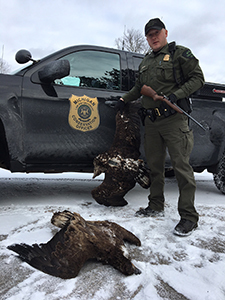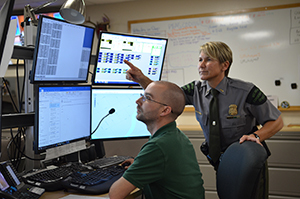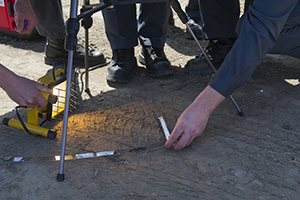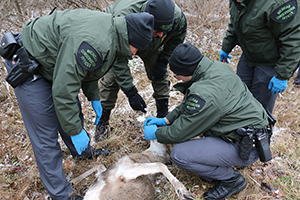From conservation officers to private citizens, protecting natural resources is everybody’s business
By KATIE GERVASI
Michigan Department of Natural Resources

Since the beginning of time, humans have relied on natural resources. Our natural resources have provided for every generation, through every century.
Cavemen relied on game and fish, just as many people still do today. Our natural resources are a valuable commodity, whether it’s timber for shelter, venison to feed a family, copper in a motor, nickel in a battery or water in a glass. But if overused or compromised, these vital resources are put at risk.
To keep the Great Lakes State great, Michigan’s natural resources require protection. It’s the responsibility of a conservation officer to protect and to preserve them for future generations.
“If no one was out there to protect the resource, the resource would lose every time,” said Sgt. Steve Mooney, a conservation officer with the Michigan Department of Natural Resources’ Law Enforcement Division in Van Buren County.
In 2017, Michigan conservation officers logged over 450,000 contacts with people. While most of these contacts resulted in public education about rules and regulations, rather than tickets or arrests, every now and then, conservation officers encountered a poacher.
Poaching is the illegal shooting, trapping or taking of game, fish or other natural resources from private or public property. This includes possessing or commercializing fish or wildlife resources contrary to Michigan or federal law.
Poachers can be a significant threat to natural resources.
The penalties for this harmful activity vary and are metered out by local courts. A poacher could be issued a ticket, and need to pay a fine, or he or she could lose hunting or fishing license privileges and serve jail time.
“There are not enough conservation officers to catch everyone,” Mooney said. “The eyes and ears of the public can see more. The more people calling and reporting, the more we know what’s going on and can narrow down situations and poaching suspects.”
|

The Report All Poaching hotline (800-292-7800) is the DNR’s 24-hour dispatch center the public can text or call to report suspected poaching. Annually, the hotline receives more than 36,000 public calls.
“We definitely need the public’s help,” said Conservation Officer Cpl. Dave Painter of Iron County. “The great thing about texting the RAP hotline is you can quietly text from the field, so you don’t have to spook the game around you.”
Complaints received on the hotline go directly to the DNR Law Enforcement Division’s communications center. A dispatcher collects information provided from the complaint and then quickly contacts the nearest conservation officer. The person calling or texting can choose to remain anonymous.
When it comes to poaching, “no one season is more prevalent then another,” Mooney said. “Typically, the opening day of a season is more common, because a poacher can lawfully possess their game. As long as they can make their shot, and get their game to the car, they think they can get away.”
The reasons for poaching vary.
“With deer, we catch a lot of poachers prior to, and at the end of, the firearm (deer hunting) season,” said Mooney. “Just before opening day, deer become more visible when they start to move. Some poachers are after the antler size and don’t want others to have the chance to get the big buck. Whereas at the end of the season, if someone hasn’t taken a deer yet, sometimes they start to get desperate, sneaking around and doing something they’re not supposed to do.”
Among the methods to stop poaching, conservation officers rely on citizens of local communities. As first responders, conservation officers live in the places they serve, allowing them to create and cultivate relationships.
“Once the community learns they can trust a conservation officer, individuals feel comfortable contacting us,” Painter said. “It can take years to develop these relationships, for people to talk to us, knowing that we will keep the conversation confidential. We rely on communities being involved. Recently, someone in the grocery parking lot told me about a poaching event.”
When a conservation officer receives a poaching complaint, whether from the RAP hotline or directly from a community member, he or she chooses the best way to begin investigating. Sometimes, this involves the use of a decoy.
DNR decoys can range from taxidermied animals or birds to more elaborate presentations, including fish with tails that move with stream currents and mechanical and remotely operated deer or turkeys.
“There’s nothing like having a decoy – you can see what someone’s hunting ethics are – you can see what someone does when they think nobody is watching,” Painter said.
As simple as the decoy process is, it involves a minimum of three officers.
“It’s all about location,” Mooney said. “You have to pick a location where the poachers are going to be.”
One officer needs to be staked out, eyes on the decoy. A second officer needs to be ready to approach the poacher, and the third needs to be in a vehicle nearby.
Decoys are great tools to catch trespassers or people who have been shining lights or shooting onto private property from a passing vehicle. If a landowner reports this behavior, decoys are a great bait to catch a poacher while in the act.
|

“Road hunting is where we get a lot of complaints,” Painter said. “Camp owners, property owners – they get upset when someone is shooting from the road and onto their property. Decoys are a tool we use to make contacts, both good and bad. Usually, the people hunting properly, ethically and legally, they love seeing us use decoys.”
Painter said he’s caught one poacher three times, two of those occasions by using decoys.
“Once with a turkey decoy, once with a grouse decoy,” Painter said. “The third time, the judge took his gun because there was a pattern of behavior and he wasn’t learning.”
Those patterns are common traits conservation officers see in poachers.
“When they’re breaking one law by poaching, they’re likely breaking multiple others,” Painter said.
Embedded within communities, conservation officers can keep a close watch on changes on the landscape.
“We’re always looking for tracks,” Painter said. “We’ve learned to investigate – why did someone pull over on the side of the road in a remote area? Most of the time it’s as simple as someone walking their dog or picking berries.
|

“But other times, we’ll find evidence of poaching – such as dumped carcasses. We’re going to look into finding the reason that someone was driving down a dead-end two-track.”
Trash piles included, conservation officers pay attention to everything.
“Poachers tend to disregard the land,” said Conservation Officer Sam Koscinski, who patrols in Manistee County. “When I’m on river patrol during the day, I’ll see a pile of garbage. I’ll check that spot later at night and find a group of anglers illegally fishing or conducting other illegal activity.
“Most people are creatures of habit. If they get away with something once, they’re more than likely to come back and revisit that area.”
Conservation officers aren’t just in the woods, they’re also in the air. Flight patrols are used to look for signs of poaching.
When conducted during the day, flights can help identify illegal bait piles, tire tracks or even an animal taken on private property and dragged to the road. Night flights can help officers spot illegal shining activity.
Officers in the air communicate to officers stationed on the ground, so the ground officer can contact a suspected poacher.
Back on the ground, officers may conduct a necropsy as part of their investigations. A necropsy is like an autopsy performed on an animal.
|

Often, an officer will recover a bullet from a carcass, which will provide evidence for a poaching case. The bullet can be matched to the type of firearm that killed the animal, along with other techniques that can indicate the time an animal was killed.
Technology, airplanes and investigative techniques aside, conservation officers agree community involvement is an officer’s best tool for preventing or stopping a poacher.
“We heavily rely on public information and calls or texts to the RAP line,” Mooney said.
“If poachers aren’t stopped, our game numbers could be depleted, like some species came close to in the 1800s,” Painter said. “Proper game management, including limiting hunting and angling methods and equipment, setting daily bag limits and establishing seasons, help ensure game populations continue to thrive.”
Historic accounts tell us that once passenger pigeons were so numerous their flocks blocked out the light of the sun, until excessive hunting helped diminish the bird’s population to extinction.
Similar tales can be told of overfishing and trapping.
With laws, rules and regulations established since those days to protect Michigan’s game, fish and other natural resources, coupled with the efforts of dedicated conservation officers and concerned citizens, the likelihood wildlife populations will remain vibrant for future generations to enjoy is increasingly secure.
Report witnessed or suspected natural resources violations, immediately by calling or texting the RAP hotline at 1-800-292-7800. DNR dispatchers are always available. Individuals may remain anonymous if they wish. Tipsters may qualify for a reward if information supplied leads to the arrest and conviction of a poacher or other violators of the law.
Michigan conservation officers are fully commissioned state peace officers who provide natural resources protection, ensure recreational safety and protect citizens by providing general law enforcement duties and lifesaving operations in the communities they serve.
Learn more about Michigan conservation officers at Michigan.gov/ConservationOfficers.
|
Check out previous Showcasing the DNR stories in our archive at Michigan.gov/DNRStories. To subscribe to upcoming Showcasing articles, sign up for free email delivery at Michigan.gov/DNR.
/Note to editors: Contact: John Pepin, Showcasing the DNR series editor, 906-226-1352. Accompanying photos and a text-only version of this story are available below for download. Caption information follows. Credit Michigan Department of Natural Resources, unless otherwise noted.
Text-only version of story
Decoy 1 and Decoy 2: Conservation officers sometimes use mechanical and remotely operated deer or turkey decoys to investigate poaching complaints.
Eagle: Conservation Officer Jared Ferguson received a complaint regarding two dead eagles in a gravel pit in Dickinson County. A suspect later admitted to shooting and hiding the birds when he found them caught in illegal coyote traps.
Instruction: Conservation officer recruits receive instruction on recovering bullets, field-dressing and performing necropsies on deer.
RAP: Complaints received on the Report All Poaching hotline (800-292-7800) go directly to the DNR Law Enforcement Division’s communications center. A dispatcher collects complaint information and then quickly contacts the nearest conservation officer.
Tracks 1 and Tracks 2: Tire tracks are one piece of evidence that conservation officer recruits learn to investigate as part of their training./
|